Forest & Shade Tree – Insect & Disease Conditions for Maine
October 27, 2022
This is the last scheduled Conditions Report update of the 2022 season. As such, it serves as a sort of year in review. We plan to provide the next installment of these regular reports in April 2023. In the meantime, keep your eyes peeled for damages, and please report significant forest health concerns.
October has been declared firewood month by Don’t Move Firewood, Hungry Pests, and PlayCleanGo.
Mainers use a lot of firewood. With the temperature dropping, many of us scramble to get that last minute firewood put up for the winter. The trees we select for firewood are typically declining or recently dead, meaning firewood produced from these trees is often more likely to harbor insects than other forest products. Lately, we’ve received a number of great photos of insect larvae in that firewood, accompanied by the appropriate question, “What the heck is this thing!?” Fortunately, all of these most recent submissions have been native insects frequently encountered in firewood piles, but the constant possibility of transporting damaging forest pest species in firewood remains one of the biggest threats to our mission at the Maine Forest Service. We welcome all the firewood questions we receive, especially those with photos, so please keep them coming!
2022 was an eventful year from a forest products regulatory standpoint due to several significant new finds of emerald ash borer in Maine, including first detections in Androscoggin and Kennebec Counties. It is important to remember that the State regulations on emerald ash borer include firewood regulation and those rules apply to the movement of all hardwood firewood species, not just ash. Therefore, changes to the regulated areas that went into effect on July 1, 2022, might very well affect how you purchase, sell, and transport firewood.
The map below shows the current areas in Maine regulated for emerald ash borer. If you operate a firewood business within a regulated area or gets wood from inside a regulated area, you may still transport firewood to customers, provided it never leaves the same regulated area. Remember that regardless of regulatory status, it is always best to transport firewood the smallest distance required or possible. If you live in a non-regulated area where EAB is not found, you cannot purchase firewood from a dealer operating within a regulated area, as delivery of that firewood is illegal. Likewise, for firewood sellers, you are not able to sell or deliver firewood from regulated areas to any customer residing in a non-regulated area.
Hunters, please be aware as land stewards of where your firewood is coming from if transporting wood to camps in remote and beautiful corners of the state. After all, tree stands are most effective where there are still live trees in which to place them. And as one final reminder, all untreated out-of-state firewood is banned from Maine and cannot be transported across Maine borders. To all our readers, please help spread the word on this important topic.
More information on emerald ash borer is found at the easy to remember www.maine.gov/eab, and firewood info can be found at the equally memorable www.maine.gov/firewood.

Browntail moth (Euproctis chrysorrhoea)
It is no surprise that this has been yet another busy year for browntail moth (BTM) with ups and downs along the way. Since our last conditions report, we have wrapped up the second round of aerial defoliation survey and extracted the preliminary data for the season. This year we mapped 72,264 acres of defoliation in the early summer and 79,452 acres in the early fall for a combined total of 151,806 acres of damage. In comparison, last year, there were 198,773 total acres of damage mapped.
 Defoliation trends by county from 2021 to 2022. Androscoggin: increase to 39,344 acres. Cumberland: decrease to 2,315 acres. Hancock: increase to 7,520 acres. Kennebec: decrease to 16,307 acres. Knox: increase to 11,320 acres. Lincoln: decrease to 4,676 acres. Penobscot: increase to 27,719 acres. Sagadahoc: decrease to 2,861 acres. Somerset: increase to 1,382 acres. Waldo: increase to 38,352 acres. Statewide total: decrease to 151,806 acres.
Looking back at the entire season, we received our first confirmed report of BTM caterpillars emerging from their winter webs beginning the week of April 11; this was followed by more widespread reports on the week of April 18. As in previous years, we continued monitoring our network of monitoring sites throughout the season. The weekly observations from these sites were posted in developmental updates for the public and stakeholders on the Maine Forest Service BTM website. We also created a Browntail News Bulletin this year.
During preliminary checks at several monitoring sites, we observed many webs with dead caterpillars on the outside from late last summer; this appears to be a little more widespread than previously thought, at least throughout Kennebec County. Starting the week of May 16, we began seeing fourth instar caterpillars at all our developmental monitoring sites. The fourth instar and older caterpillars have white markings on the sides of each body segment and have more of the irritating hairs that affect humans. At this stage of caterpillar development, their activity and appetites increase rapidly, increasing the number of irritating hairs and diminishing leaf area. During this time, we also started observing large amounts of defoliation as far north as Bangor. As in previous years, a high rate of variability in caterpillar development within sites was observed. For example, at one of our monitoring sites, there were 23-mm-long caterpillars alongside 9-mm caterpillars, indicating little development since emergence.
Many areas of Maine experienced windy weather the third week of May, which hastened the process of some of the caterpillars leaving their host trees, as many were blown to the ground. This, in turn brought more caterpillars into contact with people.
In late spring, we inoculated three sites (Deer Isle, Cumberland, and Chelsea) in mid-May with fungus-killed BTM caterpillars collected the previous summer to test if this would be a viable method for assisted disease dispersal to manage populations. All three sites later showed signs of fungus-related caterpillar mortality. This was confirmed at two of those sites within a week of inoculation and from the third site in Deer Isle by the week of June 20. These findings are promising; however, it was observed that the pathogen activity was locally confined to the inoculated trees and adjacent ones. In late May we noticed caterpillars that had been killed by a fungal pathogen at some of our monitoring sites. This was aided by a few rainy days in May.
During the last week of June and early July, we received our first reports of adult BTM. In the Capitol Region and likely other areas of Maine, noticeably fewer moths were seen at many lights in town compared to last year. We also created a simple chart to differentiate other white moths that are often confused with BTM.
In total, we received more than 500 calls and emails pertaining to BTM to date in 2022.
Emerald Ash Borer (Agrilus planipennis)
This has been an eventful year for emerald ash borer (EAB) in Maine. We discovered EAB in several new towns, including Gray, Limerick, Fryeburg, Yarmouth, and Lewiston. Disappointingly, we also found it in Oakland, roughly 40 miles removed from the nearest known infestation. Emergency orders were put in place to limit the movement of ash around many of these discoveries. Most of these infestations were discovered by people spotting woodpecker feeding on ash. Other new infestations were found using green funnel traps and girdled trap trees.
We are currently peeling trap trees girdled in the spring by staff and volunteer landowners throughout the state. If your tree has not yet been peeled and you have not made arrangements to bring it to one of our remaining log-peeling workshops, please contact foresthealth@maine.gov. We want to be sure your girdled tree is examined.
In EAB biological control news for 2022, one parasitoid wasp, Tetrastichus planipennisi, was recovered from one of the earliest release sites in northern Aroostook County. Releases at a new biocontrol site in northern Maine were started this year. In southern Maine, the second year of biocontrol releases were concluded at multiple locations in York and Cumberland Counties. We will begin monitoring for recovery of all three parasitoid species at these sites next spring. This summer, we monitored several potential future biocontrol sites with green funnel traps and girdled trap trees. Those sites where EAB was found in 2022 will be evaluated for suitability as biological control releases in 2023.
 Image: Monitoring for EAB parasitoid Oobius agrili.
Hemlock Woolly Adelgid (Adelges tsugae)
We have recently seen significant expansion in the range of hemlock woolly adelgid (HWA) in Maine. We found HWA in four new towns this year: on the island of North Haven (Knox County), in Bradley Mountain State Park in Pownal (Cumberland County), and the towns of Whitefield (Lincoln County) and Litchfield (Kennebec County). All of these towns are within the current regulated area. These new finds were reported by a landowner, a forester, hikers, and Maine Forest Service staff. We appreciate people watching for and reporting HWA in regions where it has not previously been seen.
The predator beetle Laricobius osakensis, was released last week to help manage HWA in Camden Hills State Park and on Mount Desert Island (MDI). HWA was found this summer in the forest on the border of Acadia National Park and the Land and Garden Preserve. Groups from both areas are working with the Maine Forest Service to manage this infestation on MDI. L. osakensis feeds on the winter generation of HWA, but not the summer generation. As such, it is unlikely to ever control HWA on its own but can be an important part of an integrated pest management (IPM) program. One thousand beetles were released at each of the two sites.
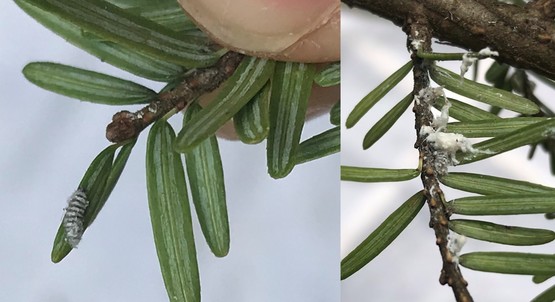 Image: (left) Laricobius larva and (right) disturbed HWA ovisacs caused by larval Laricobius feeding.
Earlier this summer, several landowners and organizations (cities, parks, schools, land trusts and conservation districts) bought and released a different HWA predator, the beetle Sasajiscymnus tsugae. This predator has two generations a year and feeds on both the spring and winter generations of HWA. S. tsugae was first released in Maine in 2004 and can still be found at the initial location. Although we cannot say with certainty that S. tsugae is capable of fully protecting hemlocks without any other intervention, we do know that some hemlocks where these predators were released are still alive 18 years later, while in other areas where predators were not released, significant hemlock mortality has been seen in a much shorter period of time. A total of 8,250 S. tsugae were bought and released at eight different locations in 2022. Again, although S. tsugae feeds on both generations of HWA, this species (in the numbers usually released) is very unlikely to control HWA on its own, and so this predator should be considered as part of a larger IPM program until its numbers can build up to provide a higher level of control.
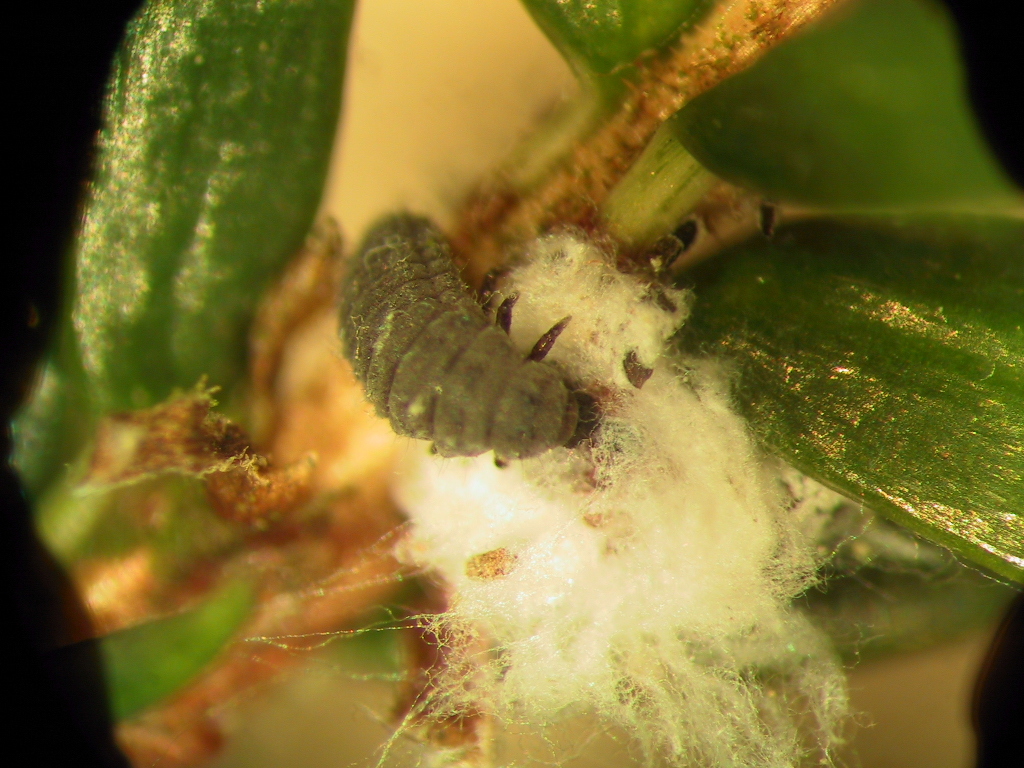 Image: Sasajiscymnus tsugae larva feeding on HWA.
Now is a good time to do any work needed on your hemlock trees. No eggs or crawlers are present, and until late February, there is very little risk of transporting HWA through contact with infested trees.
Sirex noctilio Survey
Attention to detail is important in the forest health world and even the most seemingly insignificant piece of evidence can reveal an interesting story. Take for example these unassuming resin beads on the bole of a red pine, no bigger than ¼” across. These are typically the result of a woodwasp inserting its ovipositor into a tree. If you string enough of these resin beads together visually on the bole of a tree, you can potentially retrace the path the female traveled as she looked for suitable oviposition spots. Or in a more sinister alternative, the resin beads could also be the result of a female parasitoid wasp, following the trail of a woodwasp and ovipositing her own eggs into woodwasp larvae she’s detected beneath the bark. Resin beads are just one of several things we look for when performing surveys for a newly detected pest in Maine, Sirex noctilio or the European woodwasp. While we don’t expect our readers to go out looking for resin beads, we are always looking for tips on large red pine stands with dead and declining trees. Because that is not all that uncommon here in Maine these days, we are especially interested in reports where trees are also riddled with large, round exit holes from insects. While there are many native woodwasp species that cause similar damage and chances are that’s what we’ll encounter, it never hurts to take a closer look and determine where Sirex noctilio has expanded its range in Maine. We recently recovered another Sirex noctilio specimen in the bycatch of our Exotic Wood Borer & Bark Beetle survey from a trap in Lewiston, representing the first record for Androscoggin County. Unfortunately, this is quite far from Massabesic Experimental Forest in Alfred, where Sirex noctilio was detected for the first time in Maine in 2021, meaning its range here already appears much greater than we know.
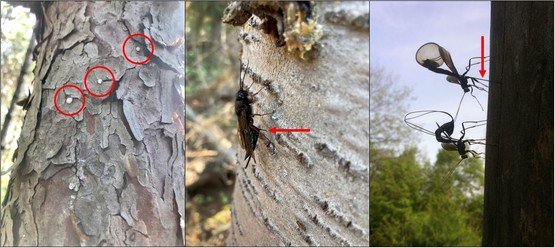 Image: (left) Red circles indicate resin beads where an insect has inserted its ovipositor into a red pine tree; (center) Example of a native woodwasp species ovipositing into a fir tree. The red arrow shows where the ovipositor is entering the tree and where a resin bead may be left behind; (right) Example of two large Megarhyssa spp. wasps using their extremely long ovipositors to parasitize woodwasp larvae within a dead tree.
Southern Pine Beetle (Dendroctonus frontalis)
The 2022 southern pine beetle (SPB) trapping survey will be wrapping up at the end of this month. This year we ran 20 Lindgren funnel traps at 15 sites throughout the state placed in key areas to monitor Maine’s hard pine resources. A portion of these traps are run by our cooperators at The Nature Conservancy (TNC) and the National Park Service. This year we adapted the timing of our monitoring program to better cover fall dispersal of SPB, whereas previous monitoring had focused on spring dispersal. The samples from this survey will be processed and any individual SPB will be recorded.
SPB is a small beetle (around 3mm long) native to the southeastern US that has been expanding its range northwards due to milder winter temperatures. It is among the more aggressive bark beetles able to attack healthy pine trees with a preference for “hard pines” such as red, pitch, and jack pine. Especially at risk are Maine’s hard pine resources, such as the inland pine barrens (a globally rare ecosystem), the pitch pine communities along Maine’s rocky coast, and red pine plantations statewide. However, there can be a silver lining to this story, as forests properly managed through thinning or prescribed fire are more resilient to SPB attack. In the absence of natural fire, disturbances like these are necessary to maintain the health of fire-adapted ecosystems like the inland pine barrens. As a landowner, TNC has been proactive in managing the pine barrens by using fire and thinning to reduce stand density and increase resilience to the beetles.
Winter Moth (Operophtera brumata)
A total of 447 Cyzenis albicans fly pupae, the biocontrol agent for winter moth, were recovered from winter moth collected in Maine this spring. These pupae were reared by our partners at the University of Massachusetts in Amherst. They will be placed inside an emergence cage, buried in the ground for the winter and will be released in the spring of 2023. Because the numbers released have been very low in recent years, we will add these to a previous release site rather than trying to establish a new site in 2023. MFS has been releasing the parasitoid in Maine since 2013, working our way up the coast with each successful establishment of the fly.
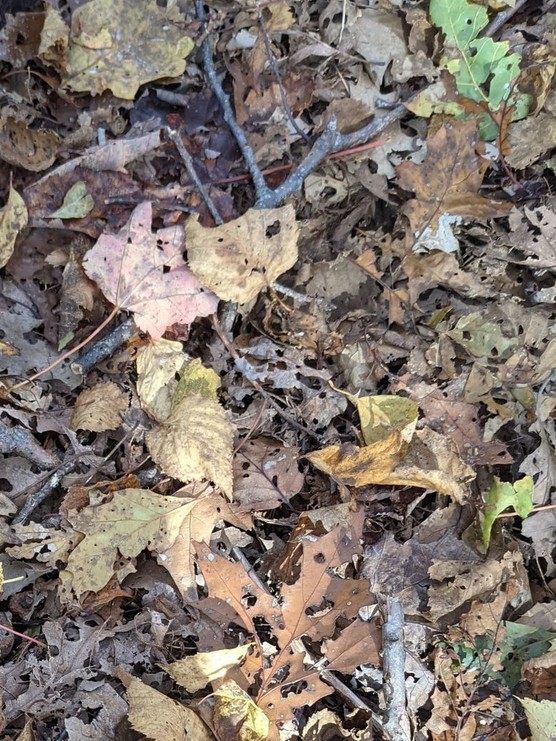 Image: Fallen leaves with typical winter moth shot hole damage. South Bristol, ME
In late May of 2022, collection efforts were conducted by Forest Health and Monitoring Staff and staff from Rachel Carson National Wildlife Refuge, an intern (Gianna Gifun) from the MFS Forest Protection Division, and Joe Elkinton and Jen Chandler from the University of Massachusetts. Over 6,700 caterpillars were collected from six field sites (two additional sites yielded no collectible material). We reared half of these caterpillars to pupation at the Insect and Disease lab in Augusta, which were then transferred to the Elkinton Lab at the University of Massachusetts. The remainder of the caterpillars were brought directly back to Massachusetts by their lab’s staff. In addition to acquiring biocontrol for future release sites, these collections show where the parasitoid has established successfully and what proportion of the winter moth population is being parasitized (see table below). Some of this work in the coming years will be supported by a grant from the USFS to the Elkinton Lab, which was announced in late June of this year.
|
Collection Site
|
Rate of Parasitism in 2022
|
|
Bath
|
4%
|
|
Boothbay Harbor
|
7%
|
|
Brave Boat Harbor Rd (Appr. three miles from
Kittery release site)
|
12%
|
|
Harpswell
|
3%
|
|
Cape Elizabeth
|
0%
|
|
Kittery
|
21%
|
|
South Portland
|
6%
|
In early May of 2022, we released 329 flies in South Bristol, Maine. This town was chosen due to its location on the coast, the abundance of severe defoliation, and the site’s suitability. We had excellent emergence this year, with mating observed as well.
This year we received many reports of winter moth damage from across coastal Maine. Reports have come in from Phippsburg, Kittery, Casco Bay Islands, South Portland, West Bath, and Harpswell. A field crew also ground surveyed severe defoliation in South Bristol and moderate defoliation in Mount Desert and confirmed winter moth damage at both sites.
Beech Leaf Disease (Litylenchus crenatae ssp. mccannii)
Beech leaf disease continues to be found in Maine in new areas, although no new county detections have been made since July. The current distribution of BLD can be seen in the map below and includes areas in Hancock, Knox, Lincoln, Penobscot, Waldo, and York counties. MFS has requested funding from the USFS Durham, NH office to continue BLD long-term monitoring plots and survey in 2023. For the latest information on BLD, check the Maine Forest Service BLD website.
 Caliciopsis canker of white pine (Caliciopsis pinea)
In 2022, MFS continued cooperation with Michigan State University, doing spore trapping to help reveal epidemiological aspects of the disease. We look forward to results of this study for better understanding of this disease and to better inform future white pine management decisions. Caliciopsis canker continues to be seen affecting the health of codominant and suppressed white pine trees and seems to be responsible for mortality among white pine seedlings and saplings in the understory of infected stands.
 Image: A Caliciopsis canker spore trap in a pole-sized pine white pine forest.
Eastern spruce dwarf mistletoe (Arceuthobium pusillum)
Eastern spruce dwarf mistletoe is a parasitic plant that can infect several of Maine’s conifer species but is most damaging to white spruce. This tree pathogen is commonly found in coastal areas of the state where it chronically weakens its host tree, leading to mortality or secondary agents that hasten tree decline. Eastern spruce dwarf mistletoe depends on its host for its nutrient and energy needs and therefore will not live long after its host tree dies. Thus, from a management perspective, infected, cut trees do not need to be burned and can be left as coarse woody debris. However, managing eastern spruce dwarf mistletoe is not easy. It is important to remember that the conspicuous witches’ brooms are not the only sign of infection. Male and female mistletoe plants (the pathogen is dioecious) occur separately on branches and reproduce for several years before brooms are produced (and sometimes no brooms form at all). These plants are not easy to detect in low populations. Also, the sticky seeds produced by the female plants are forcibly dispersed at an initial velocity of 60mph and can travel 50 feet. Further, seeds can hitchhike to new locations on birds and mammals. Eastern spruce dwarf mistletoe is common all along the coast of Maine and on its many islands, so sources of the disease for new infections are likely not far away. It is safe to assume that if you have white spruce in the coastal environment, there is a good chance you will also have dwarf mistletoe at some time and to some extent. The degree of infection and speed of decline of infected trees largely depends on vigor of the host. Vigor of the host is primarily determined by site, and most coastal and island sites are not excellent for vigorous tree growth due to drought-prone and shallow soils. This is why coastal and island spruce trees seldom look like their inland counterparts: the incidence and severity of the disease are decreased substantially as one moves inland from the coast.
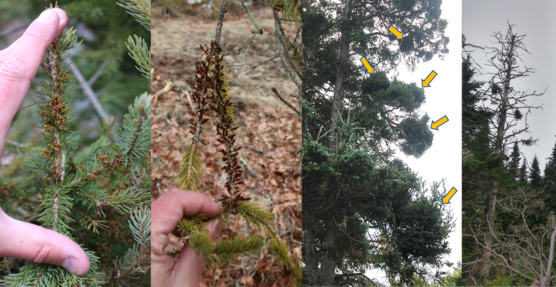 Image: (left) Male eastern spruce dwarf mistletoe plant; (middle left) Female eastern spruce dwarf mistletoe plant; (middle right) Brooms formed as a result of advanced eastern spruce dwarf mistletoe infection; (right) A tree that has died presumably due to chronic parasitism by the eastern spruce dwarf mistletoe plant pathogen; some of the brooms persist on the tree indicating the parasite’s at least partial role in the process of tree mortality.
Linden leaf blotch (Didymosphaeria petrakiana)
Presently, American basswood has relatively few common health problems, aside from its foliage being a favored food source of Japanese beetles. However, a leaf spot in the genus Didymosphaeria referred to as ‘linden leaf blotch’ has recently been noticed affecting basswood trees in Kennebec County, and the disease likely occurs elsewhere in Maine. Linden leaf blotch can be easily distinguished based on characteristics seen with the naked eye. The fungus typically only causes a few lesions per leaf, some of which can be rather large (over one inch across), and these usually show up in late summer/early fall. The lesions are dark in color and are usually surrounded by a yellow halo. The margins of lesions are not clean, and on close inspection show a branching pattern. White mycelia can also be seen in the vicinity of the lesions. Affected leaves may turn yellow and senesce earlier than usual, and these leaves may fall prematurely in autumn. As the symptoms only appear late in the year, the damage is minor relative to other leaf diseases that impact leaves earlier in the year. Thus, this disease usually is only considered an aesthetics issue and seldom warrants management. Little-leaf linden and other types of non-native lindens can be infected as well. Since the fungus that causes linden leaf blotch overwinters on fallen leaf tissue, fall cleanup of linden leaves is an effective cultural management practice. The fungus produces and releases spores in spring during basswood leaf emergence. Although there is no specific literature on linden leaf blotch management, the period of leaf emergence would logically be the target for application of fungicides to prevent successful infections.
 Image: (left) Characteristic lesions of the fungus that causes linden leaf blotch; (right) Brown arrow showing the branching character of the margins of the fungal lesions and the yellow arrow showing the often present yellow halo at the lesion margin.
White Pine Decline
In summer of 2022, the results of the regional white pine decline survey, Monitoring eastern white pine decline and its causes in New England and New York through enhanced survey methods, was published in the USFS General Technical Report 266, FHM National Status Trends and Analysis 2021. This concludes the white pine work done under an Evaluation Monitoring cooperative agreement with the USFS by a network of regional counterparts in Maine, Massachusetts, New Hampshire, New York, Rhode Island and Vermont. The report is available online at: Forest Health Monitoring: National Status, Trends, and Analysis 2021 (usda.gov). Supporters of this overall effort in Maine include the University of Maine Demeritt Forest, Maine Bureau of Parks and Lands, Maine Inland Fisheries and Wildlife, Maine Forest Service – Forest Policy & Management Division, the US Forest Service for use of the Penobscot and Massabesic research forests, Chadbourne Tree Farms, Freeman Ridge Forestry, Hancock Lumber, JD Irving, LandVest, Robbins Lumber and Sappi. Several of Maine’s private landowners are also gratefully acknowledged for supporting this effort.
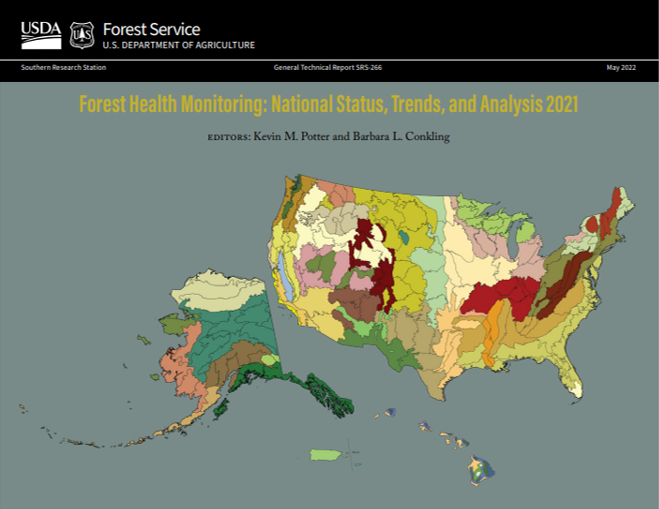
From our October 5, 1994 Conditions Report:
“Squirrel Damage- High populations of hungry gray squirrels and an abundant acorn crop have resulted in considerable oak twig pruning in some areas at least in Kennebec County. Pruned tips with acorns still attached often litter the ground. In some cases the squirrels seem to have exhibited poor judgment and have pruned tips which did not have acorns attached. With the available seed crop there should be plenty of food for these hungry creatures now and throughout the winter months. Squirrel pruned tips are usually under ¼” diameter and solid whereas tips pruned by the oak twig pruner are larger and hollow at the base.”
October 28, 2022, 12:00pm-1:00pm: via Teams Maine Forest Service Insect & Disease Update
Forest entomologist Mike Parisio will provide the latest info about insects and disease impacting forest health in Maine. There will be opportunities to ask questions at the end of the program. Co-Sponsor: Maine Woodland Owners - Virtual Forestry Info Sessions
Register
Conditions Report No. 5, 2022
On-line: https://www.maine.gov/dacf/mfs/publications/condition_reports.html
Department of Agriculture Conservation & Forestry, Maine Forest Service – Forest Health and Monitoring
Contributors: Aaron Bergdahl, Amy Emery, Allison Kanoti, Mike Parisio, Thomas Schmeelk, and Colleen Teerling.
Unless otherwise noted, images by Maine Forest Service, Forest Health and Monitoring, DACF.
|